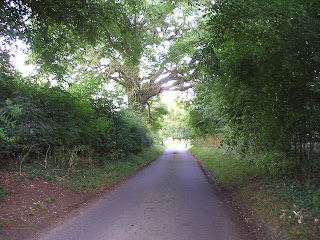Respect Your Elders
Of all trees few can be held in as much contempt as our
native elder, Sambucus nigra. It grows
almost anywhere and in such profusion that it is dismissed as a ‘weed’ and it
is true that its habit of self-sowing and growing through treasured garden
plants can be a nuisance. Despite all of
this, however, it is also one of the most useful of plants both in the wild and
the shrub border.
This variegated form of Elder is very useful for brightening up a shady place
Search any hedgerow and the Elder can be found. It is easily identified, even in mid-winter,
for its bark is dull, dry and scaly, with prominent pairs of leaf buds; these
are some of the earliest to open in the spring.
Young leaves can even be found during mild spells in the winter although
these are replaced if damaged by frost.
Perhaps the simplest way to identify a leafless plant is to break off a
stem for the centre is hollow and filled with whitish pith. Generations of
country children hollow out these stems to create ‘cigarettes’ to smoke; in
fact I can claim only to have smoked elder – and that stopped once a spark
burnt the back of my throat!
The dark berries of the elder - the red ones are hawthorn
Perhaps the glory of Elder comes in spring when the trees
burst into flower. Large, flat heads (corymbs), consisting of hundreds of tiny
scented flowers smother the plants and for a short while the countryside
carries their pungent odour. These have
traditionally been the first crop to be harvested, their flowers steeped in
water to make Elderflower cordial or ‘champagne’, these days now sold
commercially. Elderflowers can be used dried in herbal teas or, when fresh,
swirled in a light batter and dropped into hot oil to make delicious and
unusual fritters. Adding the flowers to stewed
gooseberries or when making jam is a very old method of counterbalancing the
tartness of the fruit.
Within weeks the flowers which were held upright will have
faded and drooped as berries form. Even
when green, streaks of colour hint of their ripeness to come. By late summer, the clusters have turned
almost black and make a welcome addition to fruit pies or, used on their own,
in jam and wine making.
The medicinal uses for Elder are equally varied. According to the herbalist Juliette de
Bairacli Levy all parts of the plant can be used: roots for kidney problems;
bark against epilepsy and the leaves, when mixed with geranium and garlic, to
soothe eczema and rashes. The flowers
and berries are used for relief of coughs and colds and it has also been
claimed that the flowers can restore blindness.
As with all herbal treatments caution and common sense should be used –
I’m not brave enough to suggest that you try any of them out!
For a tree with so many uses that has been part of country
lore for so long it is not surprising to find it has many names. A widespread alternative is Judas Tree for
tradition states that it was the Elder that Judas Iscariot hung himself from. It is from a derivation of the name Judas
that Jew’s Ears fungus which commonly grows on elder gets its common name.




%2B%2B%2Bcopyright.jpg)


I've been harvesting elderberries today not far from you as the crow flies. I was sad to see you write that elder is held in contempt when all the folk lore points to elder being perhaps the most respected and feared tree in the hedgerow with elaporate rituals for harvesting and the admonition never to burn elder wood because it screams. I'm pleased you mention Juliette de bairacli Levy as I'm researching her early life at the moment since none of the internet information is wholely true and she was a great one for reinventing herself every so often. You mention elder's medicinal uses but your tone implies you've never tried anything. Maybe you should. My apprentices' first task every January is to make an elderbark salve for bruises and we have documentary evidence how well it works. We use the flowers as a hot tea to promote sweating, as a cool tea to cool the body down and for cordials, champane and fritters amongst other things. I made a lovely double infused oil this year. Now the berries are ripe I will make cordials for children and elders to fight off winter ailments and elixirs for adults to help with influenza outbreaks and then there's always the hedgerow cordial which makes a wonderful alternative to mulled wine during the festive season. Elder is such a wise and generous cornucopia it seems a shame to only write about her without trying and valuing her wares.
ReplyDeleteI agree that the humble elder deserves more attention and affection. I have always loved them - even the smell which can evoke childhood in a heartbeat.
ReplyDeleteMany thanks for your comments. It is a great pity that more people don't take delight in harvesting elder.
ReplyDeleteSarah - I'm not brave enough to recommend others to try any wild plant - not just elder - over the internet!
I was messaged by someone who was brought up in Cornwall and was told as a child never to bring in the cows for milking using an elder stick for fear of bringing ill health onto the herd.
Do keep me informed of progress of the Baraclai Levy book as I'm a great fan of hers too.